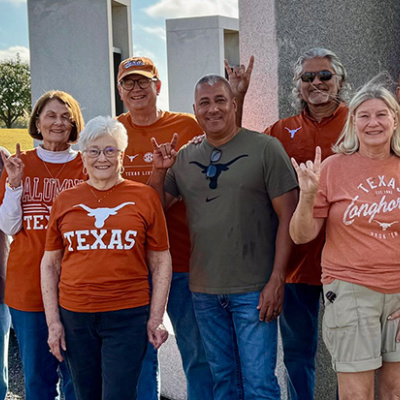Longhorns for America
Year after year, UT tops the list of schools that produce the most Teach for America corps members. It’s not only the University’s size, but also its ethos that explains why.
[caption id="attachment_2495" align="alignleft" width="630" caption="Photo by Iris Camille Claudio"]

[/caption]
Out of 46,000 applicants nationwide in 2010, The University of Texas produced the greatest number of Teach for America corps members. Why do UT students stand out from the pack?
Seems that when the corps’ leaders—who include UT alumni—think of great universities, the burnt-orange tower glows bright in the mind’s eye.
“The reason all those people applied and got in is because they had a record of achievement, working hard, and solving problems,” says Steven Farr, BA ’93, chief knowledge officer for Teach for America. “Those are the things we need in the classroom.”
UT graduates have been involved with Teach for America from the beginning. The program started in 1990 with 500 corps members, eight of them Longhorns. In fall 2010, 80 UT graduates began their two-year teaching commitment with the corps. The year before, 71 grads joined.
In 2011 5 percent of UT’s senior class applied to join the ranks of Teach for America. More than 300 corps alumni today are also Texas alumni. UT has consistently ranked in the top tier of large universities to contribute to the corps, along with the University of Michigan and Cornell University.
Jessica Brooker, a senior Plan II Honors major, was encouraged to apply to the corps by alumni she worked with while interning for state Sen. Florence Shapiro, chair of the Senate Education Committee. This fall, Jessica will be teaching special education in the Dallas metroplex. “I’m hoping I’ll be able to make gains with my students,” she says. “It’s not scary or anything. It’s a different environment. You need to have good communication skills, and, if you don’t, then you need to better yourself.”
Jessica and 4,500 college grads like her will go through a six-week training program this summer at Teach for America institutes around the country. In the fall, the grads will interview for teaching positions in 100 school districts. Although incoming corps members are assigned their subject and city when they are accepted, Teach for America does not guarantee them a position. Come August, after long summer days of training and preparation, the schools where they would be teaching decide whether or not corps members will have a job.
Corps members work in low-income schools in four regions of Texas, including Dallas, San Antonio, Houston, and the Rio Grande Valley.
After their two-year teaching commitment, some stay in the classroom. Aurora Lora, BA ’00, Life Member, was a corps member at Blair Elementary in Houston’s 5th Ward. The story of her struggles and accomplishments with students, “The Miss Lora Story,” is featured on the Teach for America website and read by every incoming corps member. Lora, the recipient of our Outstanding Young Texas Ex award in 2009, is now the founder and administrator of an all-girls academy in Portland.
Others continue the effort towards educational equality in different ways. UT’s Teach for America graduates have a history of returning to the corps and shaping the program.
Steven Farr was accepted into law school the same day he received his Teach for America acceptance. “Growing up in a family of teachers I felt very strongly that education is the key to so many other issues we are dealing with today,” he says. He deferred law school and taught high school English and English as a second language in the Rio Grande Valley area in 1993.
After graduating from Yale Law School, Farr returned to Teach for America on the administrative side in 2001. He wrote Teaching As Leadership: The Highly Effective Teacher’s Guide to Closing the Achievement Gap. His research, focused on what distinguishes successful teachers in low-income communities, has helped shaped the way Teach for America selects, trains, and supports its corps members.
“Both inside and outside of TFA there are a growing number of teachers who are proving education trumps poverty,” Farr says. “With the right educational interventions, these kids aren’t dropping out—they are going to college and succeeding. What we are trying to do is very difficult—using the classroom to change kids’ life paths—but we see teachers doing just that.”
Rich Reddick, BA ’95, assistant professor in the College of Education, says it’s the the sense of community on the Forty Acres that has brought UT to the forefront of Teach for America corps members. Reddick waited with anticipation for letters from his friend, Farr, chronicling his experiences with his students in the Rio Grande Valley. In turn Reddick, who joined the corps in 1995, sent emails to family and friends about his time in the classroom in Houston. He went on to earn a master’s and a doctorate from Harvard, the latter in education.
“It goes from knowing one person to knowing four or five people,” Reddick says. “The student leadership networks here, whether the Greek community or Student Government, are very cohesive and strong networks. There is a sense of community here at UT. We have a mission statement that mentions community service,” he says. “When it comes to any sort of endeavor where you can serve a community, you’ll see a lot of UT alums involved because that is our culture.”





